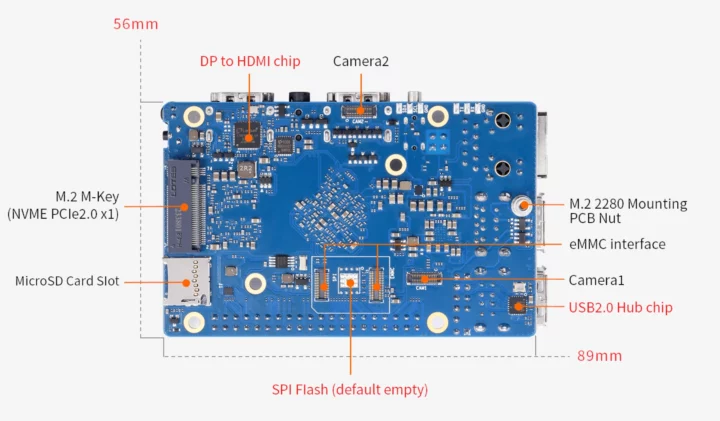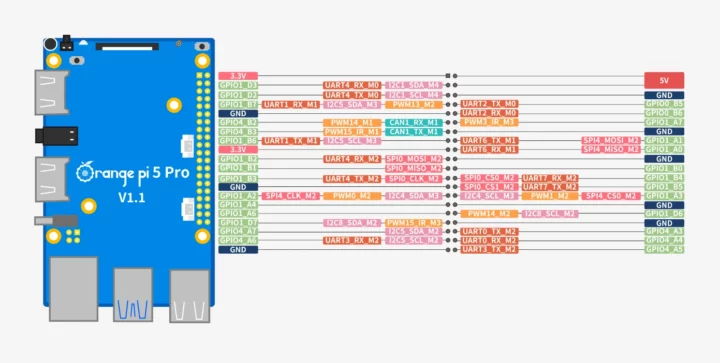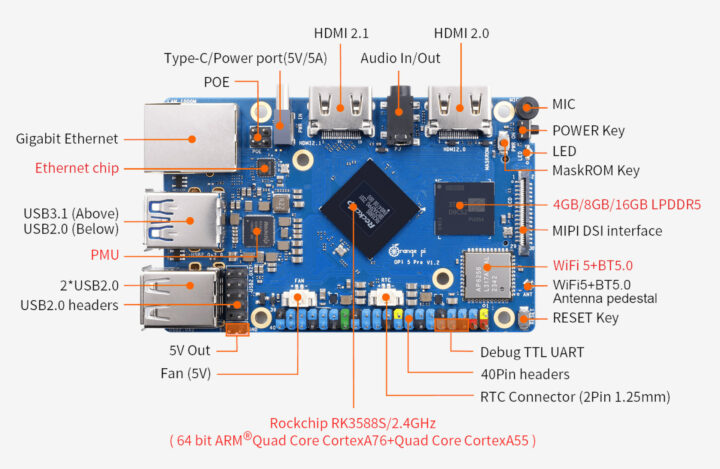As mentioned in the Orange Pi Developer Conference 2024 article, the Orange Pi 5 Pro launch was just around the corner, and the latest Rockchip RK3588S SBC is now available on Amazon or Aliexpressfor $109 and up with 16GB LPDDR5 RAM, but cheaper 4GB ($60) and 8GB ($80) variants are coming soon.
One would think the Orange Pi 5 Pro would be an evolution of the Orange Pi 5 SBC with LPDDR4 memory, and in some ways it is, but there are enough changes to display ports, storage, wireless, GPIO header, and even the form factor that make a direct comparison challenging.
Orange Pi 5 Pro specifications:
- SoC – Rockchip RK3588S
- CPU – Octa-core processor with 4x Cortex-A76 cores @ up to 2.4 GHz, 4x Cortex-A55 cores @ up to 1.8 GHz
- GPU – Arm Mali-G610 MP4 GPU with OpenGL ES 3.2, OpenCL 2.2, and Vulkan 1.2 support
- VPU – 8Kp60 video decoder for H.265/AVS2/VP9/H.264/AV1 codecs, 8Kp30 H.265/H.264 video encoder
- AI accelerator – 6 TOPS NPU
- System Memory – 4GB, 8GB, 16GB LPDDR5
- Storage
- eMMC socket
- SPI NOR Flash footprint
- M.2 2280 M-Key socket for NVMe (PCIe 2.0 x1) or SATA SSD
- MicroSD card slot
- Video Output
- HDMI 2.1 up to 8Kp60
- HDMI 2.0 up to 4Kp60 using a DisplayPort to HDMI bridge
- 4-lane MIPI DSI connector up to 4Kp60
- Camera I/F – 2x 4-lane MIPI CSI connectors
- Audio
- ES8388 audio codec
- 3.5mm audio jack with headphone and microphone support
- Onboard MIC
- Support for HDMI 2.1 eARC
- Networking
- Gigabit Ethernet RJ45 port with optional PoE+ support
- Dual-band Wi-Fi 5 and Bluetooth 5.0 with BLE support via Ampak AP6256 module, external antenna
- USB – 1x USB 3.0 port, 3x USB 2.0 ports (two behind a USB hub chip), 2x USB 2.0 via header
- Expansion
- 40-pin header with up to 28x GPIO, 4x UART, 8x PWM, 4x I2C, 1x SPI, 1x CAN Bus, and 5V, 3.3V, and GND power signals
- M.2 2280 M-Key socket (PCIe 2.0 x1)
- Debugging – UART console in 40-pin GPIO header
- Misc
- MaskROM, Reset, and Power buttons
- RGB LED
- 2-pin 5V fan connector
- 2-pin 3V RTC connector
- Power Supply
- 5V/5A via USB Type-C port
- RK806-1 PMU
- Dimensions – 89 x 56 mm
- Weight – 62 grams
 The company says the new board supports Orange Pi OS (Droid), Orange Pi OS (Arch), Ubuntu, Debian, and Android 12 operating systems. You’ll find all those images – based on Linux 5.10 – on the product page, as well as the Armbian build script on GitHub.
The company says the new board supports Orange Pi OS (Droid), Orange Pi OS (Arch), Ubuntu, Debian, and Android 12 operating systems. You’ll find all those images – based on Linux 5.10 – on the product page, as well as the Armbian build script on GitHub.
While we welcome the presence of an M.2 socket for NVMe SSD, the PCIe Gen 2.0 x1 interface will limit the performance to 5 Gbps before taking into account overheads. The random and sequential R/W speeds will still be faster than the eMMC flash, but not fully utilize the performance of most NVMe SSDs as we could confirm in our recent review of MAKERDISK M.2 NVMe SSDs with the Raspberry Pi 5.

As noted in the introduction, there are three variants whose official pricing is as follows:
- $60 with 4GB RAM
- $80 with 8GB RAM
- $109 with 16GB RAM
But right now, only the 16GB RAM, and Orange Pi told CNX Software that customers need to wait if they need cheaper 4GB or 8GB models. That means that right now, you’ll only find the Orange Pi 5 Pro 16GB SBC for purchase on Amazon and Aliexpress as well as accessories such as eMMC flash modules, camera modules, and a 5V/5A power supply.

Jean-Luc started CNX Software in 2010 as a part-time endeavor, before quitting his job as a software engineering manager, and starting to write daily news, and reviews full time later in 2011.
Support CNX Software! Donate via cryptocurrencies, become a Patron on Patreon, or purchase goods on Amazon or Aliexpress






There is a little problem with these boards – the price tag.
For me, Raspberry 5 is better, which is (easily) overclockable to 2.9GHz and has better single-threaded performance. Also, Raspberry Pis gets better software support.
Moreover, I don’t think it is just having something low-cost because other Orange Pi 5s do not have wifi and Bluetooth included in the basic price.
Aliexpress is hiding tax until checkout and postage is usually higher than local delivery.
Considering all Orange Pi boards are hugely overpriced to me Orange Pi Pro included.
To be fair, RPi competitors tend to provide better connectivity and storage in general by default. You need to compare the price of the hats for the RPi and sometimes even their mutual incompatibilities. You want to connect an M2, one hat, and it’s limited to Gen2x1, sometimes Gen3x1 if you’re lucky. You want an eMMC… well, hmmm maybe via a crappy SD-to-eMMC adapter. That quickly becomes complicated.
The RPi is fine to make people try non-x86 stuff. It sometimes even matches some real world use cases, can sometimes end up behind a TV as a monitoring system, etc. But the state of the storage on this board makes it virtually unfit for anything but hacking.
Now getting back to OrangePi. Their hardware is also far from perfect, they target low prices but when you look closer you usually have no enclosure available at all, they’re not compatible with others, and they come without NOR nor eMMC, so good luck for booting from an NVME without a microSD. the difference with RPi in fact is that you have the option to drop the SD for an eMMC at least.
OPi are definitely among those not making efforts on the software side, and it’s true that you can quickly get better mainline support on RPi than OrangePi.
There are other ones doing great hardware and taking customer feedback in consideration, like Radxa, Khadas, FriendlyELEC, HardKernel. These ones design nice products, they think about cooling, storage options, enclosures, connectivity etc and generally they do their homework for the software and even have extensive docs. Their hardware is obviously a bit more expensive but everything has a cost. Their offerings tend to make them compared to entry-level x86 boards and not to RPis in fact, because the quality and involvement are on another level.
Literally the same price as the rpi5.
They have *real* HDMI. M.2 slot built in-not a $15 add-on. eMMC and the ability to boot from SPI NOR flash. AI acceleration.
It’s like you didn’t even read the article.
RPi 5 will be interesting again if we see the launch of the unreleased 1 and 2 GB models. There’s much better “desktop” competition at the higher price points.
Rpi5 does not have SPI? With the latest firmware I was able to boot this device with a blank SSD inserted and install system over network !!!
Why? Because they worked on software support and added this feature to their boot loader. Have you seen it on Orange Pi or others?
The other ones have eMMC, SPI and all crap but HDMI output on 2k screen does not work. It also did not work on Rpi4 without specially cooked config.txt. On Rpi5 it has started working.
Why? Better software support.
Real HDMI has thick heavy cable pulling or turning ssmall SBC when it is not needed.
So I am OK with slimmer less heavy micro HDMI.
He said boot from SPI NOR. Very different thing than just having SPI or not.
The RPi5 really does not have that capability.
I don’t care. SPI NOR is not a capability I want because it is not supplied with any software. What about if you start digging in the problem and find out you need 4 times bigger SPI NOR and you had lived for 10 years how genius capability it was on paper? People wake up.
I don’t know where on Rpi5 its bootloader resides but even it is beta version I was able to successfully install Ubuntu to NVMe device over LAN without the necessity to store it somewhere and flash it to let say microSD and then flash it to NVMe.
That’s why I don’t understand Orange Pi’s pricing because Rpi5 rocks.
Xunlong preflashes SPI NOR with U-Boot. It was there when I bought Orange Pi 5+ quite a while ago.
Yes, latest U-Boot has nvme support, USB support, network support, etc. for eg. Orange Pi 5 Plus. Not thanks to Xunlong, but anyway… You can do the installation any way you like.
Do you really want to run AI on 4GB or 8GB RAM? You must be joking.
Actually I got the mistral-7B LLM to work fine quantized at Q5_KM on 8GB on other machines, but while it does work without problems, you know you’re already at the limit and you can’t even hope to ever experiment with larger models.
AI is different from LLM, although the latter is also possible but sadly running on the CPU or GPU right now. The AI accelerator can be used for computer vision. I’ve even seen the Orange Pi 5 being used in the drones in the Ukraine/Russia war.
It’s great that there’s a variety of boards available. The Raspberry Pi 5 has some advantages over this board, as do the more IO-heavy RK3588 (not S) boards. But there are also niches for the RK3588S-based boards such as this. Here’s one: applications that need hardware video encoding but not heavy IO.
Depends on use cases, but for desktop, I’ll go with ~$150 N100 16GB 256/512GB + wifi + cases. Superior for almost all kind of desktop use vs RPi5 or OPi5.
Or hunting for 2nd business minipc with upgradeable parts.
dont wanna sound rude but do you know that benchmarks do take an average for core performance? which means, it will mix the numbers between low and high end cores
i mean their architechture is exactly the same plus another 4 cores
i wont discuss about hw support but i will about wifi and bluetooth as all of their boards have had a revision with buetooth incorporated (3b- zero 1,2,3- 4b- 3lts – 4lts – zero 2w – 5b – 5 pro)
about price mmmmmm it cost its value, the thing is twice as powerful as a rpi5 has ddr5 memory emmc normal hdmi
I wonder if there is any tangible performance gain by switching from lpddr4x to lpddr5 for these rk3588(s) SBCs…
Currently there’s a problem with DRAM initialization: https://forum.radxa.com/t/rock-5-in-itx-form-factor/20005/37?u=tkaiser
But once that is resolved 4224 MT/s vs. 5472 MT/s should make a measureable difference with workloads / use cases that benefit from faster DRAM access 🙂
5.10, fortunately.
Everybody that purchased the original model should get one of these free as 16 months later, we still don’t have the full functionality across the key distros.
The RK3588 has good hardware but absolutely abysmal software based upon Rockchips dreadful support of the SOC and Orange Pi’s equally poor supprt of their own software. They are little more than box shifters masquerading as something else.
It does seem that based on efforts outside of official sources hat we may be close to some half decent software based on either 6.1 or 6.8 kernels but as was mentioned here not long ago, Vulkan support will not be here until the end of the year, 2 years since the first boards began sipping.
I am avoiding all Rockchip based products in future until they are mature and will never purchase any product from Orange Pi, regardless of what chip manufacturers they are associated with.
Development has been glacial in comparison with the rocket like advancements made with the hardware inferior RPI5, which, right now, makes it a far better bet for many a task.
That has always been the same problem with Rockchip: they start with a BSP that’s not far too old so that it’s acceptable by vendors, and they don’t invest much time mainlining stuff, though that eventually gets done (probably in part by the board vendors themselves and partners such as t-firefly). When the chip becomes obsolete the support is generally complete. They’re making progress, I think that RK3288 sort of works nowadays, 8 years after boards have stopped shipping it, and RK3588 is probably already at same support level while chips are currently being sold. Mid-end chips like RK3568 are already well supported. There’s still a long way to go for their products to be usable when the first boards are taped out :-/
^ that’s why RPi is still king os SBC space…
Honestly with serious vendors like NXP, there’s no such problem, everything works fine out of the box and is well documented. It’s usually not the same price for equivalent performance though.